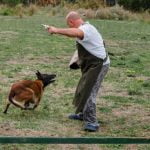Dogs, like humans, can experience fear which can manifest in various behaviors. In this article on how to train a dog not to be fearful, we will delve into the reasons behind a dog’s fear and its effects on their behavior. Fear in dogs can stem from past traumas, lack of socialization, phobias, or even genetics. Understanding these underlying causes is crucial in addressing and overcoming your furry friend’s fears.
Recognizing the signs of fear in dogs is essential for pet owners to provide the necessary support and training. Common signs include trembling, pacing, yawning, excessive panting, tucked tail, growling, or hiding. By being attentive to these cues, you can take proactive steps to help your dog feel safe and secure. Creating a safe environment at home is the first step towards building trust with your dog and helping them overcome their fears.
Positive reinforcement training is a powerful tool in building your dog’s confidence and reducing their fear responses. By rewarding desirable behaviors with treats or praise, you can encourage positive associations with situations that trigger fear. It’s important to practice patience and consistency throughout this training process for long-term success. Additionally, socialization and exposure to new stimuli play a crucial role in desensitizing your dog and boosting their resilience against fearful situations.
Signs of Fear in Dogs
Dogs, like humans, can experience fear and anxiety in various situations. It is essential for pet owners to be able to recognize the signs of fear in their dogs to address these emotions effectively. Some common signs that indicate a dog is feeling fearful or anxious include trembling, panting excessively, whining or barking more than usual, pacing back and forth, avoiding eye contact, crouching or hiding, and attempting to escape from the situation.
One crucial aspect of understanding fear in dogs is recognizing that fearful behavior can manifest differently in each individual dog. While some dogs may display overt signs of fear like cowering or growling, others may exhibit subtle behaviors such as lip licking or yawning when feeling anxious. It is vital for dog owners to pay attention to their pet’s body language and behavior patterns to identify any potential signs of fear early on.
Learning how to train a dog not to be fearful involves creating a safe environment where the dog feels secure and supported. By providing your canine companion with positive reinforcement and gentle encouragement, you can help build their confidence over time. Consistency in training methods and patience are key components in helping your dog overcome their fears and anxieties successfully.
| Signs of Fear | Description |
|---|---|
| Trembling | Visible shaking or trembling in response to a fearful situation |
| Panting Excessively | Breathing rapidly due to heightened stress levels |
| Avoiding Eye Contact | Avoiding direct eye contact as a way of signaling discomfort or fear |
Creating a Safe Environment
In addition to eliminating triggers, it’s crucial to establish a routine and structure in your home. Dogs thrive on predictability, so having a consistent schedule for feeding, exercise, and training can help reduce anxiety and build their confidence. Providing plenty of mental stimulation through interactive toys and puzzles can also keep their minds occupied and less focused on their fears. A mentally enriched environment can lead to a happier and more secure dog.
Another important aspect of creating a safe environment for your dog is ensuring that they have a comfortable space of their own where they can feel secure. Whether it’s a cozy bed in a quiet corner or a crate that serves as their sanctuary, having a designated area where they can relax and unwind is vital.
This safe haven should be equipped with familiar objects like toys, blankets, or clothing with your scent to provide reassurance when they’re feeling anxious. By offering a comforting space for your dog, you’ll be helping them feel more at ease in their surroundings.
| Safe Environment Tips | Benefits |
|---|---|
| Remove potential triggers | Minimize fear-inducing stimuli |
| Establish a routine | Promote predictability and reduce anxiety |
| Create a comfortable space | Provide security and reassurance |
Positive Reinforcement Training
One effective way to use positive reinforcement training to help your dog not be fearful is by practicing desensitization exercises. By gradually exposing your dog to the things that trigger their fear in a controlled and safe manner, you can help them learn to associate these triggers with positive experiences.
For example, if your dog is afraid of loud noises, you can start by playing recordings of gentle noises at a low volume and rewarding them for calm behavior. Over time, you can gradually increase the volume until your dog becomes more comfortable with the sounds.
Consistency is key when utilizing positive reinforcement training to build your dog’s confidence and trust. Make sure to consistently reward desired behaviors and provide reassurance during challenging situations. This will help your dog understand what is expected of them and feel more secure in their environment.
Remember that every dog is unique, so it’s important to tailor your training approach to fit your pet’s specific needs and temperament. With patience, consistency, and the right techniques, you can help your furry friend overcome their fears and lead a happier, more confident life.
Socialization and Exposure
Introduction
Socialization plays a crucial role in helping dogs overcome their fears and anxieties. By exposing them to various animals, people, and environments from a young age, you can help them build confidence and reduce their fear responses. It’s essential for dog owners to understand the importance of socializing their furry companions to ensure they grow up to be well-adjusted and confident pets.
Benefits of Socialization
Proper socialization not only helps reduce fear in dogs but also promotes positive behavior and adaptability. Dogs that are well-socialized tend to be more relaxed in new situations, less likely to display aggressive behaviors out of fear, and better equipped to handle stress. Additionally, socialization can strengthen the bond between you and your dog, as it provides opportunities for shared experiences and interactions.
Tips for Successful Socialization
When it comes to socializing your dog with other animals, people, and environments, gradual exposure is key. Start by introducing your dog to calm and friendly individuals who will not overwhelm or scare them. Use positive reinforcement techniques such as treats or praise to reward good behavior during social interactions. Additionally, consider enrolling your dog in obedience classes or group training sessions where they can learn how to behave around other dogs in a controlled environment.
Desensitization Exercises
When dealing with a fearful dog, desensitization exercises can be a powerful tool to help them overcome their fears in a safe and controlled way. This technique involves gradually exposing your dog to the source of their fear in small, manageable steps, helping them to build confidence and learn that there is no need to be afraid. Here is a step-by-step guide on how to implement desensitization exercises effectively:
1. Identify the Fear Triggers: The first step in desensitization is identifying what specific triggers cause fear or anxiety in your dog. Whether it’s loud noises, strangers, other animals, or certain environments, pinpointing these triggers will help you tailor your desensitization plan accordingly.
2. Create a Hierarchy of Exposure: Once you have identified the fear triggers, create a hierarchy of exposure starting from the least scary stimuli to the most frightening ones. For example, if your dog is afraid of strangers, start by having them observe people from a distance before gradually decreasing the distance over time.
3. Use Counterconditioning Techniques: While exposing your dog to their fears, use positive reinforcement techniques such as treats, toys, or praise to create positive associations with the trigger stimuli. This will help your dog learn that good things happen when they face their fears.
By following these steps and being patient and consistent in your training efforts, you can help your dog overcome their fears and become more confident and comfortable in various situations.
Seeking Professional Help
Recognizing When Professional Help Is Needed
If you have been trying to train your dog not to be fearful using various techniques but see little to no improvement, it may be time to consider seeking professional help. Some signs that indicate the need for professional intervention include extreme fear reactions, aggression stemming from fear, excessive anxiety or phobias, and persistent avoidance behaviors. A professional dog trainer or behaviorist can assess your dog’s specific needs and create a customized training plan to address their fears effectively.
Choosing the Right Professional
When deciding to seek professional help for your dog’s fear issues, it is essential to choose the right trainer or behaviorist. Look for professionals who have experience working with fearful dogs specifically and who use positive reinforcement-based training methods.
Take the time to research different professionals in your area, read reviews, and ask for recommendations from other pet owners or veterinarians. A good professional will not only help train your dog but also guide you on how to continue the training at home successfully.
The Benefits of Professional Assistance
Professional trainers and behaviorists have the knowledge and expertise needed to understand why your dog is fearful and tailor a training plan to suit their unique needs. They can provide support and guidance throughout the training process, helping you build a strong bond with your canine companion while addressing their fears effectively.
Seeking professional help can also save you time and frustration by providing you with proven strategies and techniques on how to train your dog not to be fearful. Remember that there is no shame in asking for help when it comes to your furry friend’s well-being.
Patience and Consistency
In conclusion, training a fearful dog requires patience and consistency. It is essential to understand that overcoming fear in dogs is a gradual process that takes time and dedication. By following the tips outlined in this article, such as creating a safe environment, using positive reinforcement training, socializing your dog, and desensitization exercises, you can help your furry companion build confidence and trust.
One of the key aspects of training a fearful dog is to remain patient throughout the process. It is important to remember that every dog is unique and may progress at their own pace.
Consistency in training methods and routines will also play a crucial role in helping your dog overcome their fears in the long run. By consistently reinforcing positive behaviors and providing a safe environment for your pet, you can support them on their journey towards becoming more confident and less fearful.
Remember that seeking professional help from a certified dog trainer or behaviorist is always an option if you feel overwhelmed or unsure about how to proceed with training your fearful dog. These experts can provide additional guidance and support tailored to your pet’s specific needs. With patience, consistency, and the right approach, you can help your beloved companion overcome their fears and live a happy, confident life.
Frequently Asked Questions
How Do You Train a Dog to Overcome Fear?
Training a dog to overcome fear requires patience, consistency, and positive reinforcement. Exposing the dog to the source of fear gradually, using treats and praise to create a positive association can help desensitize them over time.
Can a Fearful Dog Be Cured?
While it may be challenging, a fearful dog can definitely be helped and improve their condition with proper training and support. Through patience, understanding, and professional guidance if needed, a fearful dog can learn to manage their anxiety and become more confident.
How Do I Train My Dog Not to Be Skittish?
To train a skittish dog, it’s important to create a calm environment and gradually expose them to new experiences in a controlled way. Using positive reinforcement techniques like treats, praise, and reassurance can help them build confidence and trust in different situations. Remember to go at the dog’s pace to prevent overwhelming them.

Welcome to the blog! I am a professional dog trainer and have been working with dogs for many years. In this blog, I will be discussing various topics related to dog training, including tips, tricks, and advice. I hope you find this information helpful and informative. Thanks for reading!





